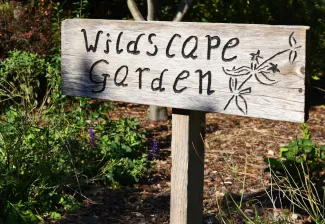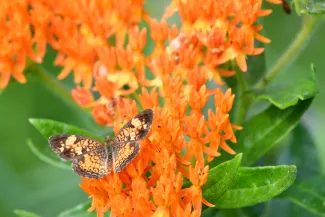Butterflies, with their iridescent wings, graceful flights, and collection of colors and patterns, are some of Oklahoma’s most popular insects. Besides serving as important pollinators of native and cultivated plants, these winged visitors are a joy to watch and are relatively easy to attract with nectar-producing plants. These three tips from our “Landscaping for Wildlife” guide are sure to bring on the butterflies.

A queen butterfly.
Butterfly Biology
Butterflies undergo four distinct life-cycle stages: egg, larva (caterpillar), pupa (chrysalis) and adult. Soon after the adult lays her eggs, the larval caterpillars will hatch and begin voraciously eating specific plants. Once the caterpillars have grown large enough, they will enter the pupa stage, when the caterpillar’s worm-like appearance gives way to a seemingly magical transformation. A wrinkle-winged adult emerges from the chrysalis shell. After stretching and drying its wings, it will probably begin feeding on nectar, sap, or detritus.
Tip 1: Plant a Butterfly Patch
Because butterflies are drawn to larval host plants and nectar-producing flowers, attracting butterflies can be as simple as planting a butterfly garden. A single native plant bed with larval host plants and nectar-producing flowers can be a central attraction for both butterflies and butterfly watchers. Your garden can be as simple as a few nectar plants in pots or as complex as a home landscape designed with sequentially flowering nectar plants. Before you begin a butterfly garden, decide from the start how much time, expense, and effort you want to invest in your habitat project. Creating a successful habitat requires more than one season of planting, so you should keep that in mind from the beginning.

Even if you invest the maximum and have the best butterfly garden in the world, you can only expect to attract butterflies that naturally occur in your area. Learn more about the species found in Oklahoma by checking out this county-level checklist, flipping through a field guide, or browsing the Xerces Society’s website. In addition to taking an inventory of which butterflies you can expect to attract, take stock of the plants in your yard, including the ”weeds” that may hold special value for pollinators. Field guides or apps like iNaturalist or Seek by iNaturalist can help you in making the correct identifications
Bonus Tips:
- Consider planting a pollinator meadow. The Xerces Society provides step-by-step instructions for selecting and preparing a site, selecting plants, and ongoing management. Be sure to check your local mowing ordinances.
- Provide shelter for hibernating butterflies and moths. Pollinator meadows can be mowed in late winter at the highest setting as some butterfly species overwinter as caterpillars or in chrysalis form in the lower part of the vegetation. A brush pile can also create shelter.
Tip 2: Plant for Color

A red admiral butterfly on blazing star.
Being a good butterfly host often means keeping flowing plants and water available. Nectar-feeding butterflies are attracted to red, orange, pink, and purple flowers arranged in clusters in sunny areas of your yard. Adult butterflies typically prefer blossoms with large petals that provide a platform where they can feed securely on nectar. Butterfly gardens can combine annual and perennial cultivated flowers with wildflowers at staggered blooming intervals to provide a continuous nectar supply.
Providing larval food plants for caterpillars as well as nectar blossoms for adults will increase your chances of attracting more butterflies. (Another advantage of providing larval food plants is that you can observe the caterpillars as they munch.) We share a list of common butterflies and their host plants below.
Bonus Tips:
- Water is another essential for butterflies. Most species obtain the water they need from flowers they visit, but many still enjoy a damp area from which to drink. Although butterflies are unable to drink from open water, you can easily provide a small puddle or seep for their use. Wet sand in a shallow dish filled with rocks or gravel can serve as a butterfly oasis.
- To make your wildscape more attractive to additional butterflies, provide rotting apples, peaches, bananas, and other fleshy fruits.
Tip 3: Soak in the Sun
Because butterflies prefer open, sunny spaces, a full-sun native wildflower garden is ideal.

A pearl crescent on butterfly milkweed.
Butterflies are ectotherms and must raise their body temperature by basking in the sun, often while perched on flat, light-colored stones. Incorporating basking areas among your sunny blooms should make your butterfly garden even more appealing.
A full-sun garden may be ideal for drawing in adult butterflies, but even the sunniest blooms will be a challenge for nectaring butterflies if the wind carries them away. A wind-sheltered garden with a fence or a windbreak of trees and large shrubs can make a sunny garden more welcoming to the winged visitors. Caterpillars may also need food plants in shaded areas.
| Common Wildscape Butterflies and Their Host Plants | |
|---|---|
| Black Swallowtail | Carrot, Dill, Fennel, Parsley, Queen Anne's Lace |
| Eastern Tiger Swallowtail | Ash, Birch, Cherry, Chokecherry, Cottonwood, Lilac, Mock-orange, Peach, Sassafras, Spicebush, Willow |
| Spicebush Swallowtail | Sassafras, Spicebush |
| Cabbage White | Sweet Alyssum, Broccoli, Cabbage, Cauliflower, Nasturtium |
| Clouded Sulphur | Clover, Showy Partridge Pea |
| Orange Sulfur | Clover, Showy Partridge Pea, Peas, Vetch |
| Gray Hairstreak | Texas Bluebonnet, Bush-clover, Tick-clover, Corn, Okra, Woolly Croton, Hollyhock, Mallows, Milkweeds, Apple, Hawthorn, Pecan, Rose of Sharon |
| Eastern Tailed-Blue | Bush-clover, Tick-clover, Clover, Peas, Vetch |
| Marine Blue | Purple Prairie Clover, Alfalfa, Milkvetch |
| Reakirt's Blue | Mimosa, Yellow Sweetclover, Illinois Bundleflower, Scarlet Pea, Prairie Clover |
| Spring Azure | Ox-eye Daisy, White Snakeroot, Apple, Blueberry, Cherry, Dogwood, Honeysuckle, New Jersey Tea, Plum, Spirea, Viburnum |
| Gulf Fritillary | Passionvine |
| American Lady | Hollyhock, Golden Ragwort, Sunflower, Thistles, Lantana |
| Common Buckeye | Indian Paintbrush, Plantain, Snapdragon |
| Mourning Cloak | Ash, Cottonwood, Elm, Hackberry, Sugarberry, Mulberry, Pear, Poplar, Willow |
| Painted Lady | Asters, Hollyhock, Lettuce, Mallows, Peas, Golden Ragwort, Sunflower, Thistle, Yarrow, Elm, Lantana, Stinging Nettle |
| Red Admiral | Stinging Nettle, Wood Nettle, False Nettle |
| Red-spotted Purtple | Apple, Cherry, Hawthorn, Poplar, Willow |
| Hackberry Emperor | Hackberry, Sugarberry |
| Pearl Crescent | Asters |
| Goatweed Leafwing | Woolly Croton |
| Monarch | Milkweeds |
| Common Checkerspot | Hollyhock, Mallows |
| Common Sootywing | Globe Amaranth, Amaranth, Lamb's Quarters |
| Hayhurt's Scallopwing | Globe Amaranth, Lamb's Quarters |
| Hoary Skipper | Brush-clover, Tick-clover |
| Silver-spotted Skipper | Brush-clover, Tick-clover, Locust, Wisteria |
| Fiery Skipper | Kentucky Bluegrass |
| Nysa Roadside-Skipper | Kentucky Bluegrass |
These tips have been adapted from the Wildlife Department’s “Landscaping for Wildlife” guide. The full guide can be viewed here.